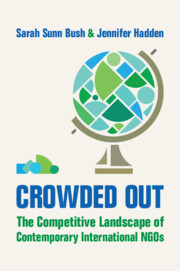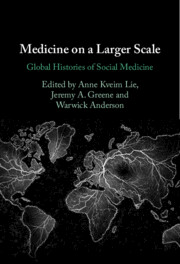Refine search
Actions for selected content:
184 results
Public Communication of Antimicrobial Resistance: A Decade of Scholarship (2015–2024)
- Part of
-
- Journal:
- Public Humanities / Volume 1 / 2025
- Published online by Cambridge University Press:
- 03 December 2025, e172
-
- Article
-
- You have access
- Open access
- HTML
- Export citation
Chapter 6 - Out of Your Mind
-
- Book:
- Selling Healing
- Published online:
- 07 November 2025
- Print publication:
- 20 November 2025, pp 96-114
-
- Chapter
- Export citation
Chapter 2 - If You Sell Your Sickness You Get a Cure
-
- Book:
- Selling Healing
- Published online:
- 07 November 2025
- Print publication:
- 20 November 2025, pp 22-46
-
- Chapter
- Export citation
Cardiology across continents: takeaways from a rare case presentation
-
- Journal:
- Cardiology in the Young / Volume 35 / Issue 11 / November 2025
- Published online by Cambridge University Press:
- 28 October 2025, pp. 2363-2365
-
- Article
- Export citation
3 - One Health and the UN Animal Welfare Nexus Resolution
- from Part I - One Health in Existing Legal Structures
-
-
- Book:
- The Cambridge Handbook of One Health and the Law
- Published online:
- 25 September 2025
- Print publication:
- 09 October 2025, pp 28-39
-
- Chapter
- Export citation
Renewing Nordic Leadership in Global Health
-
- Journal:
- Journal of Law, Medicine & Ethics ,
- Published online by Cambridge University Press:
- 07 October 2025, pp. 1-4
-
- Article
- Export citation
The potential yield of geographically targeted tuberculosis contact investigation in urban Uganda
-
- Journal:
- Epidemiology & Infection / Volume 153 / 2025
- Published online by Cambridge University Press:
- 26 September 2025, e117
-
- Article
-
- You have access
- Open access
- HTML
- Export citation
A Landscape Analysis of Pediatric and Congenital Heart Disease Services in Africa
-
- Journal:
- Cardiology in the Young / Volume 35 / Issue 9 / September 2025
- Published online by Cambridge University Press:
- 27 August 2025, pp. 1782-1791
-
- Article
-
- You have access
- Open access
- HTML
- Export citation
Candidemia in the Dominican Republic: species distribution, resistance, clinical characteristics, and outcomes at a tertiary care hospital
-
- Journal:
- Epidemiology & Infection / Volume 153 / 2025
- Published online by Cambridge University Press:
- 26 August 2025, e98
-
- Article
-
- You have access
- Open access
- HTML
- Export citation
Premorbid school performance trajectories in patients with treatment-resistant schizophrenia prescribed clozapine in the public health system in Chile: a case-control study, 2007–2020
-
- Journal:
- Psychological Medicine / Volume 55 / 2025
- Published online by Cambridge University Press:
- 21 July 2025, e205
-
- Article
-
- You have access
- Open access
- HTML
- Export citation
Cardiology across continents: key lessons from a case-based discussion
-
- Journal:
- Cardiology in the Young / Volume 35 / Issue 7 / July 2025
- Published online by Cambridge University Press:
- 16 July 2025, pp. 1450-1452
-
- Article
- Export citation
The Unsettled but Promising Interconnection of Human Rights, Mental Health, and Climate Change
-
- Journal:
- Journal of Law, Medicine & Ethics / Volume 53 / Issue 2 / Summer 2025
- Published online by Cambridge University Press:
- 15 August 2025, pp. 304-306
- Print publication:
- Summer 2025
-
- Article
-
- You have access
- Open access
- HTML
- Export citation

Crowded Out
- The Competitive Landscape of Contemporary International NGOs
-
- Published online:
- 24 May 2025
- Print publication:
- 15 May 2025
-
- Book
-
- You have access
- Open access
- Export citation
15 - Social Medicine, Otherwise
-
-
- Book:
- Medicine on a Larger Scale
- Published online:
- 05 May 2025
- Print publication:
- 22 May 2025, pp 297-317
-
- Chapter
-
- You have access
- Open access
- HTML
- Export citation
Global incidence of Kawasaki disease: a systematic review
-
- Journal:
- Cardiology in the Young / Volume 35 / Issue 5 / May 2025
- Published online by Cambridge University Press:
- 08 May 2025, pp. 1028-1039
-
- Article
-
- You have access
- Open access
- HTML
- Export citation

Medicine on a Larger Scale
- Global Histories of Social Medicine
-
- Published online:
- 05 May 2025
- Print publication:
- 22 May 2025
-
- Book
-
- You have access
- Open access
- Export citation
Social drivers of sleep experiences: Conversations with midlife working-class women from Mexico city
-
- Journal:
- Research Directions: Sleep Psychology / Volume 2 / 2025
- Published online by Cambridge University Press:
- 24 April 2025, e7
-
- Article
-
- You have access
- Open access
- HTML
- Export citation
Integrating Human and Animal Health in the STOP Spillover Outbreak Scenarios
-
- Journal:
- Disaster Medicine and Public Health Preparedness / Volume 19 / 2025
- Published online by Cambridge University Press:
- 23 April 2025, e105
-
- Article
-
- You have access
- Open access
- HTML
- Export citation
International Border Restrictions During COVID-19 as Global Health Security Theatre
-
- Journal:
- British Journal of Political Science / Volume 55 / 2025
- Published online by Cambridge University Press:
- 24 March 2025, e48
-
- Article
-
- You have access
- Open access
- HTML
- Export citation
Global Health Law: Reflections on the Past, Present, and Future of the Field
-
- Journal:
- Journal of Law, Medicine & Ethics / Volume 53 / Issue S1 / Spring 2025
- Published online by Cambridge University Press:
- 14 April 2025, pp. 81-85
- Print publication:
- Spring 2025
-
- Article
- Export citation
